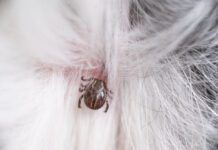I just finished reading my June issue of WDJ and, as usual, loved it! I just have one comment/question regarding “Vaccine Titer Tests” where you state, “Rabies is a slightly different case. Because the disease poses a significant risk to human beings, it’s the only vaccine that is required by law to be administered to dogs. Each state has its own legal requirements for rabies vaccination. Some require annual rabies vaccinations; the rest require the vaccination be given every two or three years (depending on the state).”
To my knowledge, the part I’ve italicized is not correct. In recent years, every state has adopted a three-year rabies vaccination policy, thanks in large part to Ronald D.
Schultz, PhD, (whom you quote elsewhere in your article) and his colleagues. That said, Dr. Schultz, professor and Chair of the Department of Pathobiological Sciences at the University of Wisconsin, Madison, and head of the Rabies Challenge Fund, notes that dog owners should check their local regulations, as municipalities in some states have the right to set rabies laws that are stricter – but not more lenient than – state policies.
Diana Laverdure
Via email
Thanks, Diana, for this correction. And thanks to Dr, Schultz and everyone else who worked to make this positive change happen! It’s important that dogs are vaccinated against rabies and equally important that they not be over-vaccinated.
I just started reading my June WDJ, and when glancing at “What’s Ahead” I was terribly excited to see that you are going to do something on L-Tryptophan.
I am sure you have already written the article, but I just wanted to say that my dog’s life was saved (well, okay, absolutely his quality of life was definitely saved) because I was able to use this very effectively when he was so OCD he could not even train for five minutes. Ruffie was diagnosed clinically as OCD (CCD for dogs, more accurately) at Tufts, by Dr. Nicolas Dodman himself. But I had to keep researching because all they wanted to do was put him on Prozac, which I refused to do.
Thanks to L-Tryptophan, Ruffian was able to completely turn around. To make a long story short, now at 10 years old, he has earned every single multiple top championship agility titles well beyond my wildest dreams. He won the CPE nationals a few years ago as well, and placed at the USDAA Regionals in tournament classes a couple of times as well. He wins classes at the DOCNA championships every year. And because of some other dietary changes (no grain, low carbs) made a few years ago, he no longer needs the L-Tryptophan either.
Barbara Rogers
Atlanta, GA
No doubt by now you’ve seen the article on L-Tryptophan in our July issue (“Talking Turkey”), which indicated that in double-blind studies (and one single-blind study), the supplement didn’t prove to be as helpful for anxiety-related disorders as some hoped it would. But we’re proponents of doing what works, with the least harm, and the supplement fits the bill in both of those categories. We’re very happy that you found “what works” for Ruffian!
Regarding “What’s SUP, Pup?”, your article on stand-up paddleboarding in the August issue: While the pastime and the bonding is admirable, I’m curious about one thing in particular.
As a dog trainer of 40-plus years and a professional mariner of 37 years, I find the pictures of the handler most grievous. While the author makes great mention of personal flotation devices (PFDs) for the dog, she makes only makes small mention of such for the handler. Drownings are common to persons ill-trained in water-related activities. Combine that with a dog who under normal circumstances is obedient and stable with an unknown situation such as distress in unfamiliar surroundings and you have a recipe for disaster.
Trent Farrell
Via email
Point taken. As the article mentioned, the Coast Guard requires the presence of a PFD on any vessel when paddling beyond the limits of swimming or surfing areas.
I was reading yet another terrific issue of the WDJ tonight, and felt like I needed to tell you how very much I value this publication. As I started thinking about it, I realized that I feel a special connection with it after all these years.
I’ve subscribed for a very long time, long before I was interviewed for an article on my use of gold bead implants for my female Doberman’s Wobblers syndrome. The gold bead implants were so successful that my dog even returned to agility.
And I really owe you thanks for the series of articles you did on various dog sports in 2009, and one in particular, on K9 Nose Work, in the August 2009 issue. I do Doberman rescue with Jane Fratesi, and Jane emailed me in November 2009 and asked me if I thought nose work would ever come to Atlanta. I told her I had an idea of how it might, and I called (frequent WDJ contributor) Lisa Rodier, whom I had known for years. The rest is how K9 Nose Work came to this part of the country, including the popular K9 NW Camp, co-directed by Lisa.
The dog I took to my first nose work workshop was my 8-year-old agility star, Parker. Once we tried nose work, we were hooked, and because I wanted to learn all about what she was doing when she hunted, I videotaped all of our training. The founders of the sport saw the videos and asked if they could use them for their first introductory DVD. That DVD was in the finals for the Dog Writers Association of America contest this past February. It lost to Turid Rugaas; no shame in that! But it remains a Dogwise best-seller. And Parker turned 12 in August.
I’ve not even mentioned the health information (I love Zeel, Wobenzyme, coconut oil, I’ve shared the Budwig diet with friends), and training ideas. And toys, and crates, and oh! Great info about food! Thanks! I’m only touching the tip of the iceberg regarding the things I love and am grateful for from WDJ!
Christy Waehner
Atlanta, GA
Christy, thanks so much for your long-time support (and occasional contributions to Lisa’s articles!). We’ve learned a lot over the years, too!




